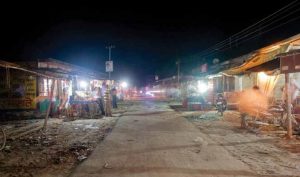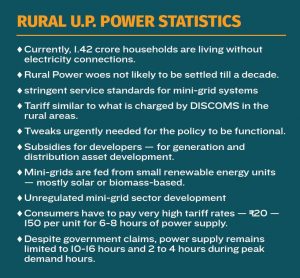 With nearly 1.42 crore households in rural Uttar Pradesh (UP) still living without electricity connections, renewable energy models like mini-grids and solar home systems appear to be the ideal solution. In fact, renewable energy models seem like an oasis in the desert as these are addressing the woes of the power consumers in villages. These privately run power packs promise to provide quality, accessible and uninterrupted electricity supply, ensuring a growth graph in terms of quality life and business. Mini-grids ensure lighting houses, smooth running of mobile chargers, fans in the scorching heat, right up to running refrigerators, computers and of course, some business gadgets. Mini-grids are proving instrumental in not only improving the condition of villages but, at the same time, helping rural folks to increase financial prosperity through better output in the business.
With nearly 1.42 crore households in rural Uttar Pradesh (UP) still living without electricity connections, renewable energy models like mini-grids and solar home systems appear to be the ideal solution. In fact, renewable energy models seem like an oasis in the desert as these are addressing the woes of the power consumers in villages. These privately run power packs promise to provide quality, accessible and uninterrupted electricity supply, ensuring a growth graph in terms of quality life and business. Mini-grids ensure lighting houses, smooth running of mobile chargers, fans in the scorching heat, right up to running refrigerators, computers and of course, some business gadgets. Mini-grids are proving instrumental in not only improving the condition of villages but, at the same time, helping rural folks to increase financial prosperity through better output in the business.
All is good except for the fact that this prosperity quotient comes at a very high price. The rural consumers pay a hefty price per unit than the urban folks. More so, even the tariff rates per unit are not fixed that vary from 20 per unit and can go up to as high as 150 per unit for 6-8 hour power supply. In many cases, quality control is also in doubt.
A report by Centre for Science and Environment (CSE), an environmental research and advocacy organisation on mini-grids in Uttar Pradesh clearly said that it is unlikely that Prime Minister ambitious Sahaj Bijli Har Ghar Yojna (SAUBHAGYA) or Deen Dayal Upadhyaya Gram Jyoti Yojana will be able to give “dedicated push to improve village electrification for the entire 1.4 crore people.” The report said that it will require from seven to ten years before this can be done.
The CSE recently held a round-table meeting in Lucknow to discuss the role of mini-grid electricity generators in addressing the energy access challenge in rural Uttar Pradesh. According to a report, one-fifth of the rural population of India continues to live without electricity access despite the massive growth in electricity infrastructure in recent years.
Incidentally, Uttar Pradesh became the first state in the country to implement dedicated mini-grid policy and regulations. The object was to ensure access to power at affordable rates, providing viable exit options and encouraging development of standard distribution networks.
“Unfortunately these have had little impact as no developers have set up projects under the state policy,” said the CSE report.
The mini-grid developers know that they have just a decade to do business in the state and that is why they too are in a hurry to draw maximum profit from their business. So the poor rural power consumer is totally powerless and at the mercy of the mini-grid promoters.

Realising it is in a no-win situation, the government is also rather soft on these developers. After all, they are doing to an extent what the government should be doing and so the morally bound government cannot put hurdles in the way of those in the mini-grids market.
Defending these high charges one of the developers stressed that remoteness comes with inherent cost. “UP ki majboor hai, mini-grids zaroori hai (Mini-grids are must for UP’s growth),” said a developer not wishing to be identified.
Severely power starved, rural folks in the state have to pay the price for quality and uninterrupted power supply in his household. Mini-grids and solar home systems is the only solution, at least for the next decade.
As the electricity crunch is likely to persist, there is a strong chance of mini-grid development in the state over the next 5-10 years. The issue is how and how much the UP government can get them to follow the rules and reduce tariff for the poor rural consumers to breathe easy. The report suggests that UP makes Policy changes to provide subsidies to developers in order to support the transition to mini-grids, suggested by CSE. It also recommends tariff rates similar to those being charged by DISCOMS in rural areas
It is clear that while UP has to give big sops to the mini-grid developers so that they, in turn, reduce the financial burden through reducing tariffs for the rural consumer of power.
State government’s attempt to regulate tariffs and improve the supply of mini-grids through its mini-grid policy in February 2016 has found no takers and has thus failed to achieve its objectives.
According to the CSE report, not a single developer seems to have availed the state subsidy or is operating a project under its ambit.
“This is because it fails to address the developers’ concerns of project viability at low tariffs and commercial uncertainties,” said the CSE report.
Tweaks in the existing policy mechanism and the business/revenue model can result in mini-grids providing adequate, reliable and affordable electricity to all. This will encompass setting minimum standards in terms of hours of electricity supply, reasonable tariffs for consumers and viable operational and commercial terms of agreement for developers.
letters@tehelka.com













